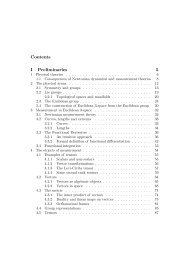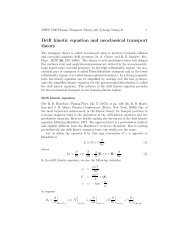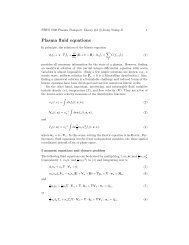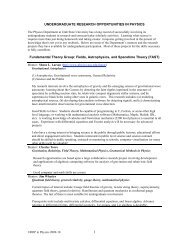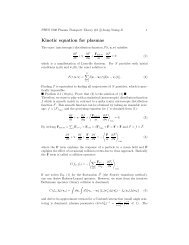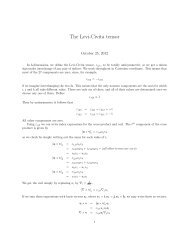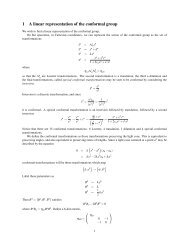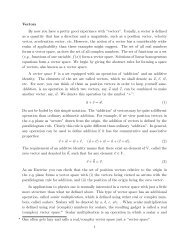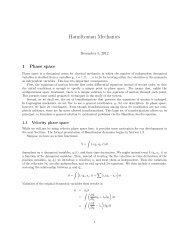Wheeler, Mechanics
Wheeler, Mechanics
Wheeler, Mechanics
You also want an ePaper? Increase the reach of your titles
YUMPU automatically turns print PDFs into web optimized ePapers that Google loves.
Finally, since b must have an inverse, and its inverse cannot be a, we must fill in the final spot with the<br />
identity, thereby making b its own inverse:<br />
◦ a b<br />
a a b<br />
b b a<br />
Comparing to the boolean table, we see that a simple renaming, a → 1, b → −1 reproduces the boolean<br />
group. The relationship between different representations of a given group is made precise by the idea of an<br />
isomorphism.<br />
Let G = (S, ⊕) and H = (T, ⊗) be two groups and let φ be a one-to-one, onto mapping, φ, between G<br />
and H. Then φ is an isomorphism if it preserves the group product in the sense that for all g 1 , g 2 in G,<br />
φ (g 1 ) ⊗ φ (g 2 ) = φ (g 1 ⊕ g 2 ) (1)<br />
When there exists an isomporphism between G and H, then G and H are said to be isomorphic to one<br />
another.<br />
The definition essentially means that φ provides a renaming of the elements of the group. Thus, suppose<br />
g 1 ⊕ g 2 = g 3 . Thinking of h = φ (g) as the new name for g, and setting<br />
eq.(1) becomes<br />
h 1 = φ (g 1 )<br />
h 2 = φ (g 2 )<br />
h 3 = φ (g 3 )<br />
h 1 ⊗ h 2 = h 3<br />
Applying the group product may be done before or after applying φ with the same result. In the Boolean<br />
case, for example, setting φ (a) = 0 and φ (b) = 1 shows that G = (◦, {a, b}) and H = (⊕ 2 , {0, 1}) are<br />
isomorphic.<br />
Now consider a slightly bigger group. We may find all groups with three elements as follows. Let<br />
G = {{a, b, c} , ⊗} , where the group operation, ⊗, remains to be defined by its multiplication table. In order<br />
for G to be a group, one of the elements must be the identity. Without loss of generality, we pick a = e.<br />
Then the multiplication table becomes<br />
⊗ e b c<br />
e e b c<br />
b b<br />
c c<br />
Next, we show that no element of the group may occur more than once in any given row or column. To<br />
prove this, suppose some element, z, occurs in the c column twice. Then there are two distinct elements<br />
(say, for generality, x and y) such that<br />
From this we may write<br />
x ⊗ c = z<br />
y ⊗ c = z<br />
x ⊗ c = y ⊗ c<br />
But since c must be invertible, we may multiply both sides of this equation by c −1 and use associativity:<br />
(x ⊗ c) ⊗ c −1 = (y ⊗ c) ⊗ c −1<br />
x ⊗ ( c ⊗ c −1) = y ⊗ ( c ⊗ c −1)<br />
x ⊗ e = y ⊗ e<br />
x = y<br />
8



